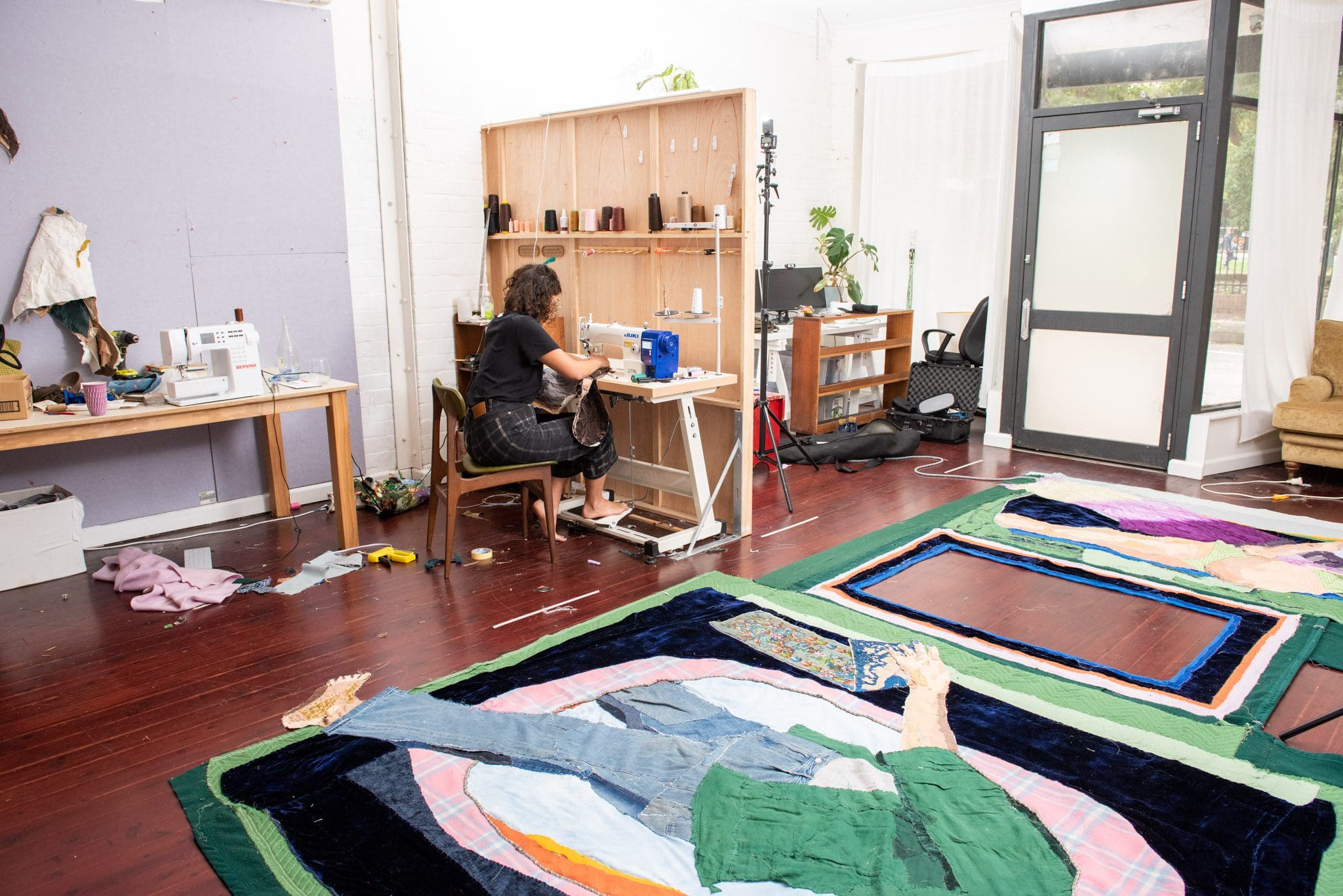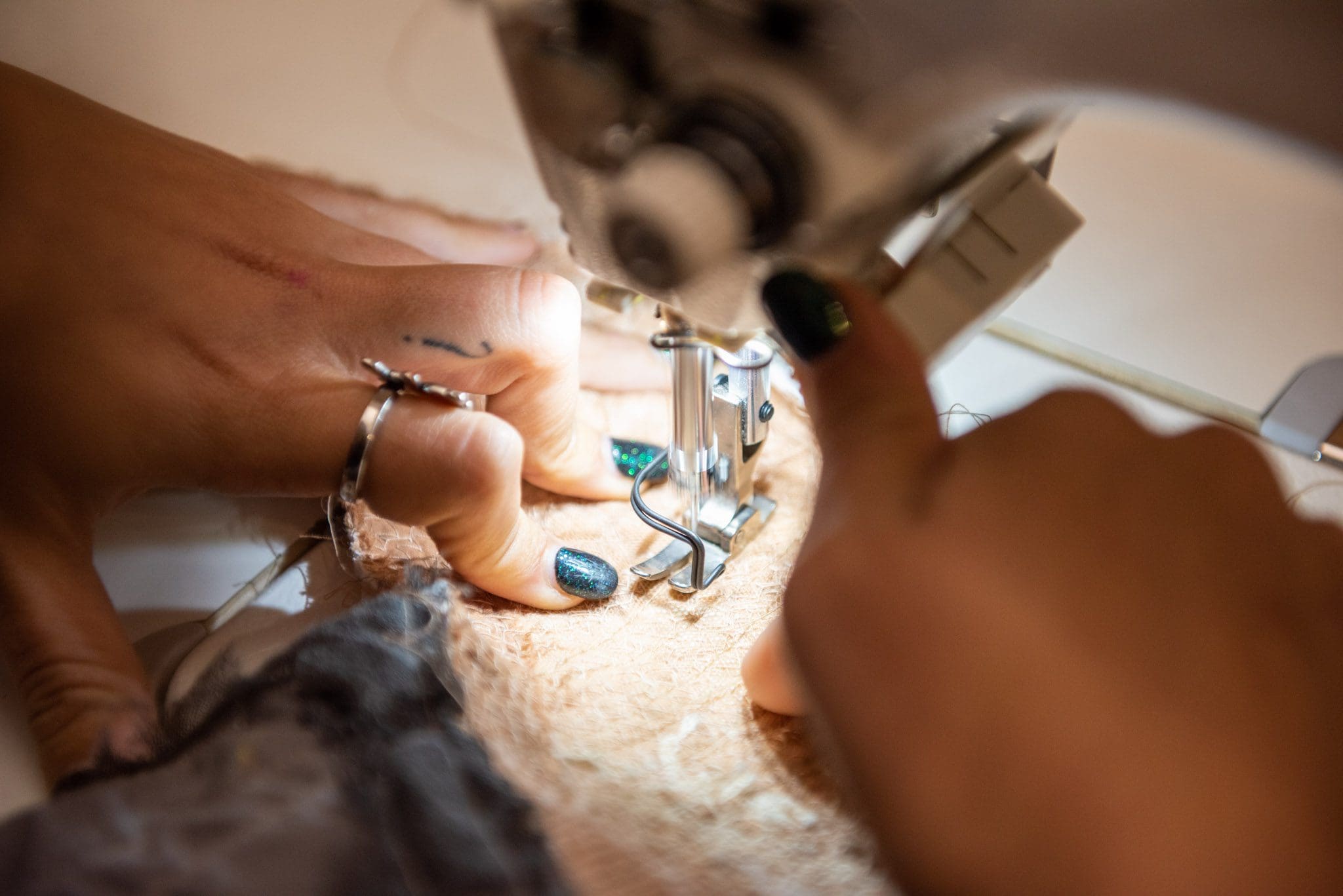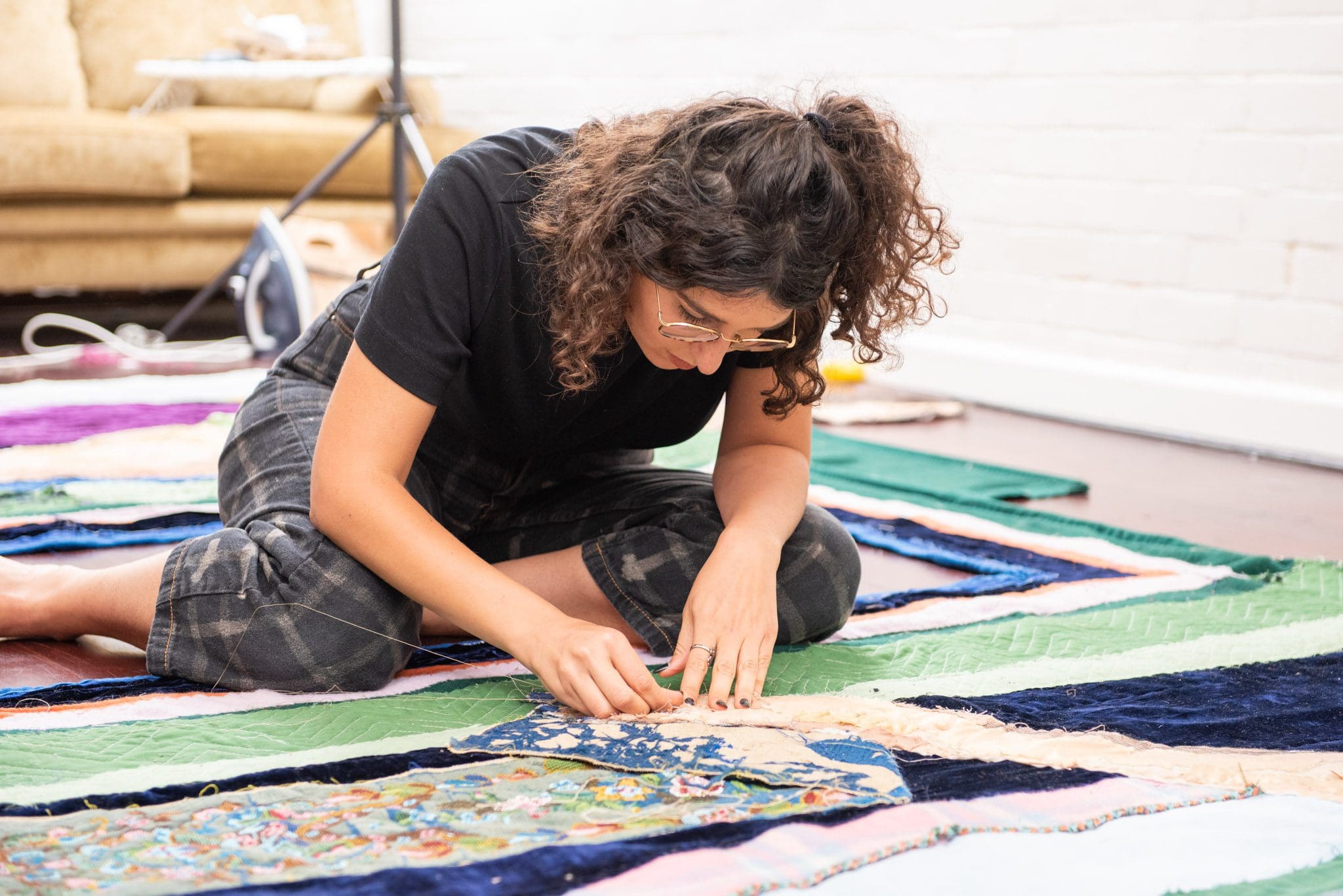
Poetics of Relation
Tender Comrade, currently on show at Sydney’s White Rabbit Gallery, creates a new vocabulary of queer kinship by reimagining the relationship between artworks, bodies and space.
Julia Gutman works with textiles donated by family and friends, creating layered figurative tableaux referencing personal and shared histories, which often recall imagery from canonical paintings. In mid-2022 she presented her first solo exhibition, Muses, at Sullivan+Strumpf in Sydney, prior to which she was a finalist in the 2021 Ramsay Prize and was awarded the 2020 NSW Visual Arts Emerging Fellowship. Ahead of her inclusion in Primavera 2022 at the Museum of Contemporary Art—a show featuring artists under age 35—we stepped inside Gutman’s studio in Lewisham in Sydney’s inner west, learning how connection is central to her practice.

Place
Julia Gutman:
I’ve been in this space for about a year-and-a-half. I share it with a close friend who’s a director. It’s nice to have that collaborative energy in the studio. We have a lot of thematic overlaps, but different kinds of work, so it’s nice exchanging ideas. I was in the Waverley Artist Studios, and when that ended at the end of 2020, I started looking for a space. This is close by to where I live, and I like how it feels. It’s got so much character, it’s a good size, and it’s cosy. I spend most of my time here… a little home away from home.
My work is very labour intensive, and it’s nice to have a lot of time and space to focus. I get easily distracted. When there are lots of people around I have amazing conversations, it’s very inspiring—but I don’t get quite as much done. [It’s a balance] between having the time to actually make the work, and making sure that you have community around you. During Covid-19 lockdowns, even though I was in Waverley, a lot of work happened in my bedroom. [Now I’m] able to work at scale and have space to organise all my things.

Process
Julia Gutman:
I have all the materials that get donated to me colour-coordinated into a big palette, which makes working easier. I have an abundance now, which means I can do more. In earlier work, I was trying to create a figure out of fabric that didn’t intuitively lean towards that. Now there are more options.
I like working with transparency. I love tulle; anything that I can lay out in a painterly way to create tones.
Because the process of making the work is so laboured, and gives an imprint of time, the images tell [multiple] stories at once. They’re often referencing something from a canonical painting. The second layer is the moment that I shared with the person who’s in the work, who it is representing. You’ve also got the stories of all the donated materials, and [another] story is the studio, you can see the energy and pacing. So even though they’re static images, they play with time. I hope, when you look at them, you get a sense of process and are thinking about the action of making them.
I still work with everything that’s donated to me by people in my life. But something that’s shifted is [that] I feel more trust in what I’m doing and people around me do too, so more precious things can enter the work—with faith that they’ll be safe and worked into something else, thoughtfully. In the Primavera work, there’s a little tapestry that was made by my great-great-great grandma that’s been sewn in, and some things from my late grandmother. My mum, when she was pregnant with myself, my sister [and] my brother, [made] needlepoint tapestries. We grew up with a set of chairs that [featured] the tapestries… they’re 30 years old now. I’ve consulted the whole family, and I’m going to make a work with those tapestry tops. Sometimes we’re too worried about mementoes, and then they end up not being seen.

Projects
Julia Gutman:
The work for Primavera plays with perspective and [includes] figures coming in and out of portals. The figures… feel like they’re getting swallowed up by this fabric or by [the] familial history in this work. It’s that tension between moments when you feel like a distinct individual, and moments when you feel like a small part of a whole, or of a lineage or community.
It’s called, Isn’t it just one long conversation? I’ve been thinking about this sense that we’re all conversing with people we’ve never met. We’re all shaped by one another, always interacting with someone’s past, heritage, experience or relationships. I think there’s something beautiful about the fact that the figures I’m creating are people in my life, and all the materials are donated by people in my life, but those people don’t all know each other. They are interconnected, and are shaping each other, it’s just not direct.
There’s a beautiful essay on borders that was the catalyst for this work, from Siri Hustvedt’s book Mothers, fathers and others. It draws together individual experiences of borderlessness, that moment of the boundary between self and other breaking down, but uses it as a way to talk about political borders. She writes about motherhood and birth as a moment where there is no physical border between mother and child. This work was made while my sister was pregnant. There’s a monumental figure of her with my niece in her belly and she is made from something of mine, something of my mum’s, something of my grandma’s.
I’m doing some residencies in 2023. I’ve been in nonstop production mode. I just want to teach, travel and experiment. In June I’m going to be in Palazzo Monti in Italy, which I’m really excited about. I turn 30 in July, then in August I’m going to Fountainhead in Miami. I didn’t like the idea of travelling and having these experiences with a deadline—I feel like I wouldn’t be able to totally engage.
Everyone You Are Looking at is Also You
Julia Gutman
Sullivan+Strumpf, Melbourne
21 March – 27 April 2024
This article was originally published in the January/February 2023 print edition of Art Guide Australia.